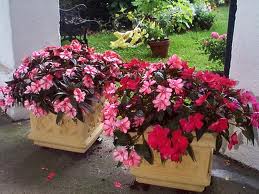Balsaminaceae
Balsam family
Touch me – not family
Balsaminaceae includes only 2 genera but many species of annual and perennial herbs which are widely distributed in the tropics, with a few in northern temperate regions. They are well represented in India and Asia. Leaves and stems are more or less fleshy. Flowers are bilaterally symmetricab turned upside down, with a petal – like sepal bearing a spurlike nectar tube to ward the back of the flower. The fruit is a dry capsule that opens explosively or a small, berrylike drupe.
Impatiens includes approximately 850 species of annual and peren nial herbs and shrubs, with greatest diversity in Southeast Asia and Africa. Hybrids are the most commonly cultivated forms. They have complex and uncertain ancestry. Most are from montare regions and prefer moderate temperatures. Because of their low tolerance for heat and cold they are commonly grown as mild season annual. Balsams demand regular moisture. They are not good choices. Where irrigation is inadequate or where subject to drought restrictions. A thick layer of mulch greatly reduces irrigation requirements. Never plant there or other ground covers with high moisture requirements under flowering trees and shrubs of fruit trees that require a dry season. The excess moisture during dormancy will decrease the bloom or fruit or may permanently harm the tree Balsams are suitable for containers and hanging baskets. Species impatiens are interesting alternatives to the ubiquitous hybrids. All are susceptible to snails, sucking and chewing insects, damprot, and mildew.
Impatiens auricoma
Madagascar, Mascarene Inlands Comoro, Islands. Perennial herb, 2-3ft, zones 10-11. Blooms fall, winter, spring. Regular moisture and humidity. Fertile, humus – rich, well – drained soil. Part sun to bright filtered light. Flowers: yellow – orange, upper petals form a hood, lower petals a 2 – lobed lip, spur short. Leaves: ovate to elliptic, to 4 in . long, margins crenulate, petiales with several stalked glands.
Inpatiens New Guinea Group hybrids
no – me – toques
Garden hybrids. Perenial subshrub, 18 – 24 in, zones 10-11. Blooms mild seasons. Regular moisture and humidity. Fertile, hum us – rich, well – drained soil. Full sun to bright filtered light. Flowers: various colors: lanceolate, tip tapering dark metallic green with red midvein sometimes marked with yellow, margins finely tothed. New Guinea hybrids involve I. hawkeri with leaaves that are longer and more colorful than those of I. walleriana hybrids.
Impatiens pseudoviola hybrids
Garden hybrid, I. pseudoviola X
Perennial herbs to 12 in, zones 10-11. Bloom mild season. Regular moisture and humidity. Fertile, humus – rich well – drained soil. Full to part sun.
Flowers: White and magenta – purple orange, or lavender – pink, spur short. Leaves: ovate, dark green succulent, margins finely scalloped”Hawaiian purple” and ” Hawaiian Orange” are hybrids of unknown ancestry involving Impatiens pseudoviola, a mounding species with white or lavender, violet – shaped flowers.
Impatiens sodenii
Giant impatiens, giant touch-me-not, no-me-toques gigante
Synonym; I. oliveri. Tropical eastern Africa. Perennial subshrub, 3-8 ft, zones 10-11. Blooms winter, spring. Regular moisture and humidity. Fertile, humus- tich, well – drained soil. Bright filtered light. Flowers: pink to white, to 2 in. wide, spur curved. Leaves: oblanceolate, glossy dark green, in whorls, margins finely toothed. Stems: dark green.
Impatiens hybrids
Impatiens, balsam, busy lizzie, sultana, no-me-toques
Garden hybrids. Perennia herbs, 12-16 in, zones 10-11. Bloom mild seasons. Regular moisture and humidity. Fertile, humus -rich, well drained soil. Full sun to bright filtered light. Flowers: many colors, spur straigh. Leaves: variable, ovate to elliptic, 1-4 in. long, fleshy, margins scalloped, petioles often with stalked glands. Many Impatiens hybrids are of uncertain ancestry. They generally involve I. walleriana (African origin) and/or I. balsamina(Asian origin). New double – flowered selections resemble tuberous begonias.



Deprecated: strpos(): Passing null to parameter #1 ($haystack) of type string is deprecated in /home/agriviek8Qv/agriviet.net/public_html/wp-includes/comment-template.php on line 2522